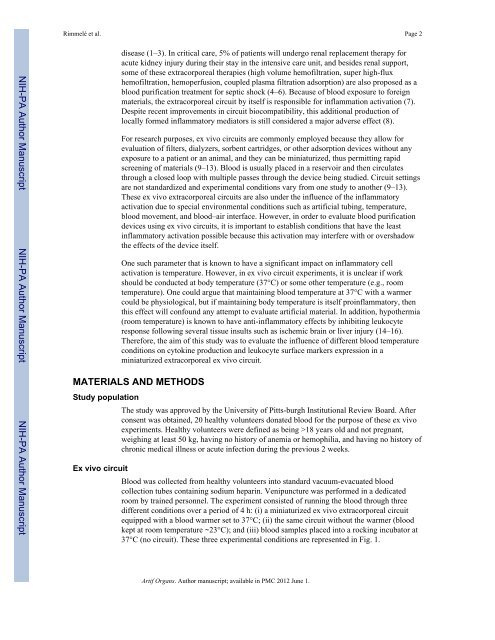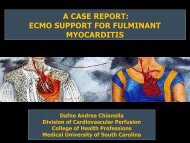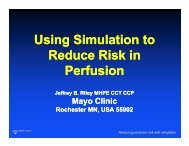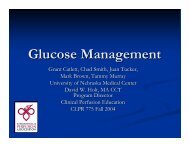Read the Full Text (PDF) - Perfusion.com
Read the Full Text (PDF) - Perfusion.com
Read the Full Text (PDF) - Perfusion.com
You also want an ePaper? Increase the reach of your titles
YUMPU automatically turns print PDFs into web optimized ePapers that Google loves.
Rimmelé et al. Page 2<br />
NIH-PA Author Manuscript NIH-PA Author Manuscript NIH-PA Author Manuscript<br />
disease (1–3). In critical care, 5% of patients will undergo renal replacement <strong>the</strong>rapy for<br />
acute kidney injury during <strong>the</strong>ir stay in <strong>the</strong> intensive care unit, and besides renal support,<br />
some of <strong>the</strong>se extracorporeal <strong>the</strong>rapies (high volume hemofiltration, super high-flux<br />
hemofiltration, hemoperfusion, coupled plasma filtration adsorption) are also proposed as a<br />
blood purification treatment for septic shock (4–6). Because of blood exposure to foreign<br />
materials, <strong>the</strong> extracorporeal circuit by itself is responsible for inflammation activation (7).<br />
Despite recent improvements in circuit bio<strong>com</strong>patibility, this additional production of<br />
locally formed inflammatory mediators is still considered a major adverse effect (8).<br />
For research purposes, ex vivo circuits are <strong>com</strong>monly employed because <strong>the</strong>y allow for<br />
evaluation of filters, dialyzers, sorbent cartridges, or o<strong>the</strong>r adsorption devices without any<br />
exposure to a patient or an animal, and <strong>the</strong>y can be miniaturized, thus permitting rapid<br />
screening of materials (9–13). Blood is usually placed in a reservoir and <strong>the</strong>n circulates<br />
through a closed loop with multiple passes through <strong>the</strong> device being studied. Circuit settings<br />
are not standardized and experimental conditions vary from one study to ano<strong>the</strong>r (9–13).<br />
These ex vivo extracorporeal circuits are also under <strong>the</strong> influence of <strong>the</strong> inflammatory<br />
activation due to special environmental conditions such as artificial tubing, temperature,<br />
blood movement, and blood–air interface. However, in order to evaluate blood purification<br />
devices using ex vivo circuits, it is important to establish conditions that have <strong>the</strong> least<br />
inflammatory activation possible because this activation may interfere with or overshadow<br />
<strong>the</strong> effects of <strong>the</strong> device itself.<br />
One such parameter that is known to have a significant impact on inflammatory cell<br />
activation is temperature. However, in ex vivo circuit experiments, it is unclear if work<br />
should be conducted at body temperature (37°C) or some o<strong>the</strong>r temperature (e.g., room<br />
temperature). One could argue that maintaining blood temperature at 37°C with a warmer<br />
could be physiological, but if maintaining body temperature is itself proinflammatory, <strong>the</strong>n<br />
this effect will confound any attempt to evaluate artificial material. In addition, hypo<strong>the</strong>rmia<br />
(room temperature) is known to have anti-inflammatory effects by inhibiting leukocyte<br />
response following several tissue insults such as ischemic brain or liver injury (14–16).<br />
Therefore, <strong>the</strong> aim of this study was to evaluate <strong>the</strong> influence of different blood temperature<br />
conditions on cytokine production and leukocyte surface markers expression in a<br />
miniaturized extracorporeal ex vivo circuit.<br />
MATERIALS AND METHODS<br />
Study population<br />
Ex vivo circuit<br />
The study was approved by <strong>the</strong> University of Pitts-burgh Institutional Review Board. After<br />
consent was obtained, 20 healthy volunteers donated blood for <strong>the</strong> purpose of <strong>the</strong>se ex vivo<br />
experiments. Healthy volunteers were defined as being >18 years old and not pregnant,<br />
weighing at least 50 kg, having no history of anemia or hemophilia, and having no history of<br />
chronic medical illness or acute infection during <strong>the</strong> previous 2 weeks.<br />
Blood was collected from healthy volunteers into standard vacuum-evacuated blood<br />
collection tubes containing sodium heparin. Venipuncture was performed in a dedicated<br />
room by trained personnel. The experiment consisted of running <strong>the</strong> blood through three<br />
different conditions over a period of 4 h: (i) a miniaturized ex vivo extracorporeal circuit<br />
equipped with a blood warmer set to 37°C; (ii) <strong>the</strong> same circuit without <strong>the</strong> warmer (blood<br />
kept at room temperature ~23°C); and (iii) blood samples placed into a rocking incubator at<br />
37°C (no circuit). These three experimental conditions are represented in Fig. 1.<br />
Artif Organs. Author manuscript; available in PMC 2012 June 1.
















